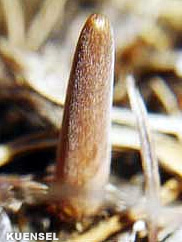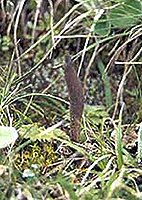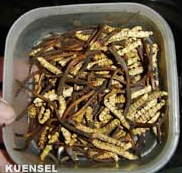|
|
| Cordyceps sinensis - Yartsa Goenbub in Bhutan |
| Highly
valued medicinal plant |
 |
Bhutan's Nature Yartsa Goenbub |
|
 |
Bhutan Information |
|
|
 |
 |
|
Why the magic fungus is on the wane?
|
 |
 |
|
Cordyceps
Sinensis
|
|
There are a number of factors that have led to its decline
Researchers on cordycep's conservation and management say a combination of several factors has resulted in slimmer pickings of the highly valued magical fungus this season.
While climatic factors, like snowfall and rainfall, contribute to the growth of cordyceps, management in collecting and trading also play a significant role in its growth, experts with the RNR research development centre in Yusipang, said.
Cordyceps growth is enhanced by unusually high precipitation, during the preceding monsoon season or in the form of winter snowfall, especially when followed by mild temperatures in spring, Dr Purna Bahadur Chhetri (PhD) said. |
|
People in the northern gewogs of Laya, Lingshi and Lunana said reduced snowfall and rainfall this year had decreased the growth of cordyceps in their locality.
Researchers also attributed the reduced growth to lack of proper management and over-harvesting.
"Although the collection is regulated on paper, monitoring is weak," a researcher said. "Such lack of monitoring would contribute to over-harvesting, which would lead to disruption in its ecology, and thus reduce production."
Management of the collection and trading, experts pointed, would help in preserving the overall ecology of the cordyceps and sustain the growth.
Dr Purna Bahadur said the highlanders harvest the cordyceps individually, which would affect the overall ecology of its habitat, and put it in bad shape and affect the growth. "There are no farmers' groups or cooperatives," he said. "A presence of such groups would look after various aspects of the collection, management and trading."
Citing an example of the cordyceps growth pattern, Dr Purna Bahadur said that people in the mountains are permitted to collect cordyceps in June, the peak period of its growth. "The ones growing in July to August must be preserved for the next season, but a lot of illegal poachers collect cordyceps in all seasons," he said.
Listed under schedule I in the Nature and Conservation Act, 1995, a royal decree in 2004 legalised its collection by the people residing in the alpine region, as a source of additional income.
 |
|
Dr Purna Bahadur said studies in mountain areas like Namna, Bomjetenkha, Nakchula and Soe showed the decrease in growth could be a cyclic event of three to five years.
"While it takes three to five years for the larvae to emerge as fungus after infection, it could be possible that there weren't many infections of larvae in the past three to five years," Dr Purna Bahadur said.
|
|
|
He said agents responsible for carrying the ascopres from fungi to larvae are not known, but it is believed that the ascopres (the seed of the fungi) are wind dispersed, and larvae get infected while feeding on the soil surface.
Dr Purna Bahadur Chettri also said unavailability of food could have also affected production, as the larvae feeds on roots of the alpine flora, such as the rhododendron species.
Lack of climatic information in the high mountains has made it difficult for the researchers to authenticate any findings.
Researchers have pointed out that concerned authorities should install instruments to read weather.
Meanwhile, with the one-month cordyceps collection permit ending this month, highlanders expect to make up for a smaller harvest from a hike in prices.
Laya gup Kinley Wangdi said, although the growth fluctuated in previous years, the condition is worse this year. "But we're hoping that we'll fetch good price, as less supply means higher demand," he said.

|
| This
article was contributed by Tashi Dema, KUENSEL, Bhutan's national newspaper 2012 |
|
Cordyceps
sinensis |
 |
By
word-of-mouth, the detail of this wonder tonic eventually reached the Chinese
Royal Court about one thousand years ago. For hundreds of years Yartsa
Goenbub was used in Traditional Chinese Medicine.
But
only the Emperor and his immediate court could use it. It has only been
in the last few hundred years that it has trickled down to the ordinary
man on the street. But so expensive has it traditionally been, only the
well-off could afford Yartsa Goenbub.
Yartsa
Goenbub is not eaten on its own. In herbal medicine it is cooked with meat
(usually duck or chicken) to help lung, kidney and heart function. When
Yartsa Goenbub is cooked with pork it prevents impotence making it a natural
Viagra! Cordyceps sinensis can be found in herbalists' shops throughout
East Asia. I have seen it on sale in China, Hong Kong, Japan and Thailand.
Thai supermarkets sell small jars of 'chicken essence and Cordyceps' tonic
drink. However, it is the recent move into new markets (especially North
America and Europe) that has put a large strain on demand.
| Information on Bhutan |
 |
|





